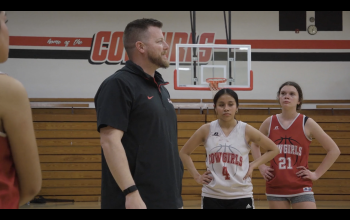High school students from around the region headed to Iowa Central Community College in Fort Dodge last Thursday, Jan. 30, to take part in a Culinary Career Discovery Day. The students had signed up to spend the day learning about grilling techniques, knife skills, pastry making and decorating techniques…but there was one more surprise they weren’t expecting. Chef Michael Hirst, director of the Culinary Arts Program at ICCC, had lined up a very special guest speaker…and he brought a friend with him.
Ethan Bubeck of Lewright Meat Inc. in Eagle Grove greeted the students at ICCC as they walked into the Hanson Center Culinary Auditorium. He looked just like any other speaker, until ICCC culinary students rolled in “Henry,” the name they would soon give to the half hog carcass on the cart.
“We’re about to watch a master work his craft,” said Hirst amongst a few gasps of shock and moans of the thought of what was to come. Other high school students, however, appeared excited at the opportunity to learn something unexpected.
Hirst added that he invited Bubeck, who has been butchering for 14 years in the business that has been in his family for 82 years, because he wanted both the high school students as well as those students already enrolled in the Culinary Arts program at ICCC to get the idea that it’s important to understand where the food they are preparing comes from and how it gets to their kitchen onto the customers plate.
Bubeck began by explaining that Lewright Meats Inc. is a full service locker, which means they bring the animals in the back door live and send them out the front door packaged per customer specifications for cuts of meat. Next, he explained the safety equipment he uses, noting that they were all equally important in keeping him safe. There is a belly pad that in the case of a knife slip will shield him from puncturing his stomach and vital organs; a helmet, and a cut-proof glove on his left hand since he is right-handed and holding the carcass with his left hand. But perhaps one of the most important tools, he explained to the students, is a very sharp knife.
“More people cut themselves with dull knives than sharp ones,” said Bubeck.
At Lewright Meats Inc., they use Switzerland Knives which are laser sharp, demonstrating to the kids that it can cut a piece of paper with ease.
As he prepared to start carving the hog into what he called “primal cuts,” he told the students that each animal in their facility is inspected by the State of Iowa, one of only two locally-owned lockers that do that in the state of Iowa.
“Our customer is our highest priority,” Bubeck said.
He began the butchering process by disconnecting the head.
“Believe it or not, this is a delicacy in some countries,” he told the students as some watched in disbelief.
He would later explain which parts are eaten.
Next he disconnected the jowel (neck and glands for which some people use for bacon), removed the kidney and other organs, and then he began cutting the pieces of meat that we traditionally eat in our area.
The first cut was what we refer to as the Boston Butt. Interesting enough, it’s not near the butt area at all. That’s where the bacon comes from. Instead, it’s at the front top of the pig right behind the pig’s neck. The reason for it’s name, according to Bubeck, is from its shipping methods. Back in the Colonial days, less desirable (considered back then) cuts of meat used to be shipped to Boston in barrels referred to as “butts.” Hence the name. The class seemed intrigued at this fun fact.
Throughout the rest of the remaining hour, Bubeck showed them how to cut a boneless loin, St. Louis style spare ribs, the shoulder, ham, bacon, the ham hock (pork shank), and explained what “trimmings” went into making the ground pork. He also explained how they smoke the meat at Lewright Meats Inc. and that they process an average of 20 – 30 hogs a week.
One detail-oriented student noticed that throughout the demonstration Bubeck was throwing “waste” into it’s own separate bucket and wondered how Lewright Meats Inc. disposed of the waste. Bubeck explained that they don’t just throw it out, but instead it is sent on to be made into animal feed, mostly for chickens.
Although no Eagle Grove students were present in this day’s activities (they have participated in ICCC educational days in the past), there were two Clarion-Goldfield-Dows High School students who attended. Amity Johnson and Alexis Maxson, both juniors, said they were rather intrigued by the whole process. The part they liked best…naming the pig Henry.
Lewright Meats Inc. processes meat for individual customers, as well as for wholesale distribution to Ames, Nevada, Des Moines, Huxley, and others.
In addition to learning first-hand from Bubeck and Chef Hirst and some of the ICCC Culinary Arts students, the high schoolers also got the chance to meet and talk with Megan Martin, a ICCC Culinary Arts program graduate. She is now employed as a pastry chef at the prestigious “Spoon and Stable” located in Minneapolis, Minn. They have been visited by such special diners as Steven Tyler, Pink, and Adam Levine to mention a few. While they have eaten her desserts, she nor the other employees ever bother the famous guests as is their rule of courtesy. But she told the students, it just goes to show you never know where the talent of being a good chef can take you.
“This is an industry where you do something new every day,” Hirst told the high school students. “We’re people who like to make people smile with food.”



